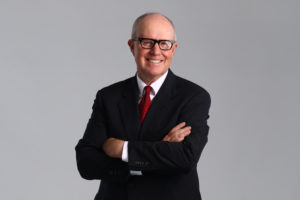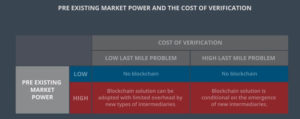When considering how blockchain can help healthcare, it’s first useful to consider what the barriers to adoption and barriers to entry are.

The barriers to entry for new blockchain solutions are, in part:
- Cost of verification.[1] In most, if not all, business interactions that require the mediation of a third-party entity, the cost of networking is usually high and cumbersome, especially when the parties involved in the transaction are located within different geographical locations. Because blockchain technology is based on open-source code, it is unlikely that the barrier to entry and competitive advantage, [2] will be achieved merely by solving the cost of verification problem.
- Cost of networking. The cost of networking affects the cost to bootstrap and operate a digital marketplace or digital information exchange without assigning control to a centralized intermediary. This is achieved by combining the ability to cheaply verify state with economic incentives targeted at rewarding state transitions that are particularly valuable from a network perspective, such as the contribution of the resources needed to operate, scale, and secure a decentralized network. The resulting digital marketplaces allow participants to make joint investments in shared infrastructure and digital public utilities without assigning market power to a platform operator, and are characterized by increased competition, lower barriers to entry, and a lower privacy risk. [3] Again, as with cost of verification, because blockchain technology is based on open-source code, it is unlikely that the barrier to entry and competitive advantage, [4] will be achieved merely by solving the cost of verification problem.
- The last mile problem. The last mile problem creates a significant opportunity who understand that blockchain does not necessarily remove the need for intermediaries, but instead changes the nature of intermediation. [5] For example, one last mile problem is associating medical records to humans. This has been discussed in several published papers. For example, one of the most common myths surrounding blockchain and identity is that blockchain technology provides an ideal distributed alternative to a centralized database for storing personally identifiable information (PII), such as (a) use of blockchain to store the data; (b) use a blockchain as a distributed hash table (DHT) for PII data stored off-chain. Neither of these are optimal, because of the cost of verification and the cost of networking. But Blockchain technology is much more than a distributed storage system. Self-sovereign identity (SSI)[6] has been proposed as a way of establishing a shared ledger of events, while maintaining the privacy of the individual and only sharing on the edge of the network.[7]
- Secret sauce: Unique trusted governance creates a barrier to entry. Because of their decentralized nature, blockchain introduce new types of inefficiencies and governance challenges.” [8] It has been said that Trust-less governance is the killer app of blockchain technology because it enables “pure governance embedded in code running on the internet — [that] influences the real world, the lives of millions of people through their investment decisions and the allocation of real-life resources, like electricity. And it doesn’t need any trusted parties, agents working for it.” [9] Investors such as Burniske have said that “Governance is the new defensible asset open and getting commoditized (coordination of all the actors).”[10]
How the healthcare industry can benefit from the use of blockchain technology
While there is a last mile problem in healthcare, the network effect is extremely powerful, of the last mile problem can be solved. But network effect has to be enabled with proper governance and a new type of intermediary.
Problem Statement
Current Horizontal Solutions to address these problems, such as IBM’s private blockchains have limitations. As Catalini has pointed out, “Private blockchains, deliver all the benefits of this new, exciting wave of technological change without disrupting how businesses run their operations. The catch is that permissioned blockchains take advantage of only one of the two, key costs affected by blockchain technology: the cost of verification.”[11]

Outline of Vision
If you have a high last mile problem, such as the one that exists in healthcare of linking a blockchain token to a human identity then the blockchain solution is conditional, based not the disintermediation of the industry such as healthcare, but the emergence of new intermediaries.
The healthcare intermediary bridges the gap between patients / healthcare consumers who have trust issues regarding their privacy, health care providers who create siloed charts that are not easily shared intra-provider, and health plans that provide siloed and complex financial data.
Blockchain Technology Solution
The blockchain solution will be provided as follows:
- Customer: The Customer will be the entity with the largest financial incentive to implement it and enable proper governance. This customer identity is confidential but is a large national organization.
- Technology: A shared ledger that reports events but does not share identity except with trusted edge of network participants.
- Identity: A consumer / patient facing brand with a back-end enterprise data source for national U.S. organization(s).
- Competition: Legacy systems and processes such as electronic health records, claim systems, regulatory agencies and financial institutions.
Digital Ecosystem and Token Distribution
The next section in the primer asks you to outline the workings of your business’s digital ecosystem and explain how tokens will be utilized. Here, you should describe the following:
- Costless verification will be enabled for the healthcare consumer using known data today such as a combination of unique personal identifiers used in healthcare and biometrics
- The token brand has been identified. The bootstrapping of the network will be enabled by offering incentives to those who are the largest stakeholders in financial risk and loss. These players are confidential.
The Last Mile
Under this heading, describe the last mile problem as it pertains to your business.
- The primary issue will be re-educating people that blockchain is not best used for central or off chain storage of identity but that the shared ledger of events helps create the important aspects of identity.
- Blockchain shared ledgers powered by our financial and business partner that touch some of the largest healthcare providers and payers in the U.S.
[1] Christian Catalini Massachusetts Institute of Technology (MIT) – Sloan School of Management; Joshua S. Gans University of Toronto – Rotman School of Management; Some Simple Economics of the Blockchain. “The cost of verification relates to the ability to cheaply verify state, including information about past transactions and their attributes, and current ownership in a native digital asset.”
[2] Catalini – What are the disadvantages of ICOs? “If the codebase is open source and the token is widely distributed, it starts to look a lot more like a commodity,” See https://mitsloan.mit.edu/ideas-made-to-matter/pros-and-cons-icos-entrepreneurs
[3] Christian Catalini Massachusetts Institute of Technology (MIT) – Sloan School of Management; Joshua S. Gans University of Toronto – Rotman School of Management; Some Simple Economics of the Blockchain. https://papers.ssrn.com/sol3/papers.cfm?abstract_id=2874598
[4] Catalini – What are the disadvantages of ICOs? “If the codebase is open source and the token is widely distributed, it starts to look a lot more like a commodity,” See https://mitsloan.mit.edu/ideas-made-to-matter/pros-and-cons-icos-entrepreneurs
[5] Catalini: Why Blockchain Can Be Good For Competition – Catalini Forbes
[6] Self-sovereign identity (SSI) is a model for managing digital identities in which an individual or business has sole ownership over the ability to control their accounts and personal data. See https://www.techtarget.com/searchsecurity/definition/self-sovereign-identity
[7] Dan Gisolfi. Self-sovereign identity: Why blockchain? https://www.ibm.com/blogs/blockchain/2018/06/self-sovereign-identity-why-blockchain/
[8] Christian Catalini Massachusetts Institute of Technology (MIT) – Sloan School of Management; Joshua S. Gans University of Toronto – Rotman School of Management; Some Simple Economics of the Blockchain. https://papers.ssrn.com/sol3/papers.cfm?abstract_id=2874598
[9] Michal Bacia. Trust-less governance is the killer app of blockchain technology. See https://medium.com/the-mission/trust-less-governance-is-the-killer-app-of-blockchain-technology-1f5881b4e6ce
[10] Chris Burniske is a partner at Placeholder, a New York venture firm that invests in decentralized information networks. Prior to Placeholder, he co-authored, Crypto assets: The Innovative Investor’s Guide to Bitcoin and Beyond, and spearheaded ARK Invest’s crypto efforts, including its 2015 bitcoin investment.
[11] Catalini: Why Blockchain Can Be Good For Competition – Catalini Forbes
